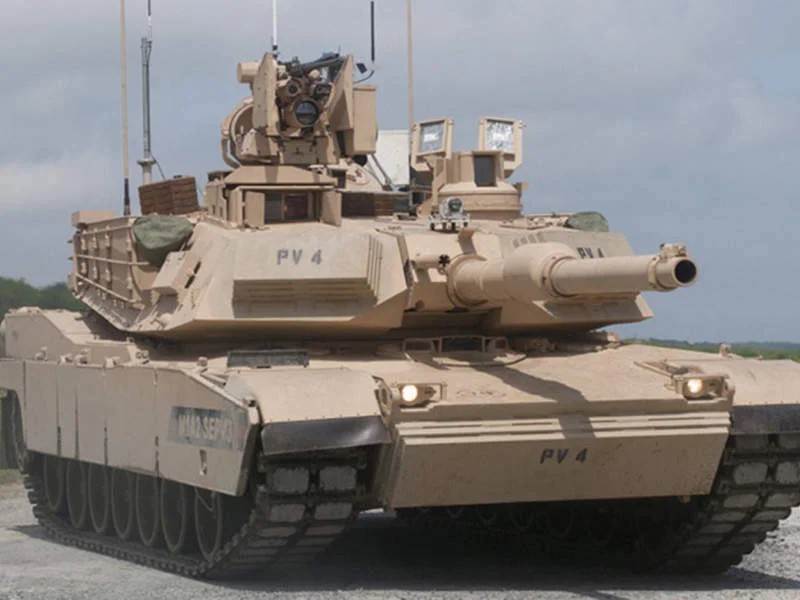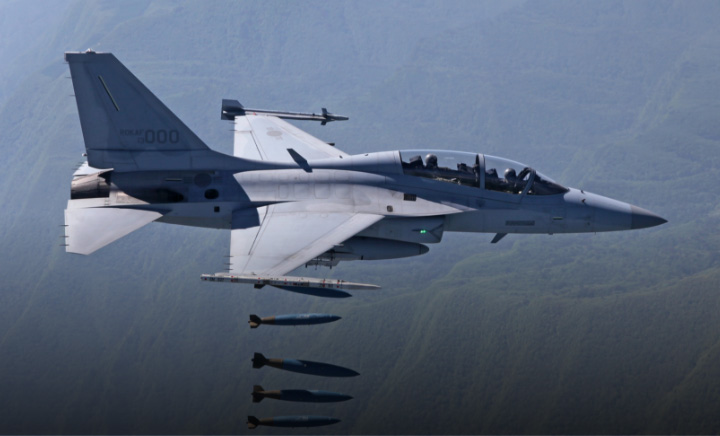The recent signing for the purchase of 48 FA-50s by Poland allows us to look back at recent orders for Polish military equipment. In terms of tanks, for example, the Polish Land Force has purchased a total of 1,346 battle tanks on various occasions, most of which are very modern, including the latest version of the American Abrams or the Polish version of the South Korean K2.
Signing for 48 FA-50
This is the latest order regarding this ramp-up policy. Indeed, the Polish prime minister signed two contracts on Sept. 16 with KAI for the delivery of a total of 48 FA-50 light attack aircraft:
- 12 FA-50 block 10 aircraft delivered in the middle of next year
- 36 FA-50PL block 20 aircraft delivered between 2025 and 2028
The block 10 standard allows for the carriage of Lockheed Martin's AN/AAQ-33 Sniper pod. In fact, this light attack aircraft will be able to designate targets for its laser-guided bombs. The second delivery, on the other hand, will be upgraded to block 20, adding a beyond visual range (BVR) capability, allowing the firing of AIM-120 AMRAAM medium-range air-to-air missiles and the addition of an active antenna radar (AESA).
A technical and training center with simulators in particular will be built around 2026. It will allow the modification of the first 12 FA-50s to FA-50PL standards (including improvement to block 20, interconnection with the Topaz system). Polish President Andrzej Duda also said that these aircraft will allow the retirement of the MiG-29 and especially the Su-22 attack aircraft. These attack aircraft will perform peacetime air policing missions to relieve the current F-16 fleet, pending the arrival of the F-35A.
However, Poland is not stopping at a few more fighter aircraft, as the paragraphs below show.
180 K2PL tanks... for now !
In late July, Poland signed a contract with South Korea to purchase 1,000 K2 main battle tanks. For now, only the first phase of the contract is underway, with the purchase of 180 K2 Black Panther. The first deliveries are scheduled for the end of this year. The second phase is to include the licensed construction of about 800 K2PLs. The Polish defense minister also speculated that the 180 K2s may eventually be upgraded to the K2PL standard.
The K2PL tank will differ from the K2:
- longer chassis
- seven road wheels instead of six (as a result of the longer chassis)
- additional armor (turret and chassis)
- increased mass of 5 tons (with a total mass of 60 tons)
- Polish communication systems
- Polish battlefield management system Topaz
The two images below, however, help to confirm that many components will be common between the two models. No reliable source specifies the armament used, although the 120mm cannon appears to be the same on both models.




The latest version of the Abrams
On April 5, 2022, the State Department gave approval for the delivery of 250 M1A2 SEPv3 MBTs, 26 M88A2 ARVs and 17 M1110 bridge launchers to Poland. A second order was placed on 15 July for the delivery of 116 second-generation M1A1s. The 116 second-generation Abrams are intended to fill the capability gap created after the delivery of T-72M/T-72M1(R) (~230) and PT-91 tanks (number unknown) to Ukraine. The 116 tanks were previously used in the U.S. Marine Corps (USMC) until their retirement in 2020 when the USMC decided to divest itself of its battle tanks. In contrast, the 250 Abrams are extremely new as production began in October 2017. They will allow for the final retirement of Polish battle tanks still dating from the Soviet era. The "obsolescence" of the M1A1s may be only temporary since it will be possible, as in a 2018 US Army order, to upgrade them to M1A2 SEPv3 standards.
For key features;
- The M1A1 Abrams is the first modernization of the Abrams tank with a second-generation FLIR and analog architecture and finally, the addition of a lightweight command and control system that allows for the location of friendly forces on the battlefield.
- The M1A2 SEPv3, for System Enhancement Program version 3, is the most modern version of the U.S.-origin battle tank. It is a corrected version of the Abrams following the lessons of the Iraq War in 2003. The electrical power is increased, added a system on the health of the vehicle, integration of a system against IEDs and most importantly, a new auxilary power unit allowing silent surveillance of the battlefield.
- The M1110 JAB (Joint Assault Bridge) is an M1A1 Abrams tank whose turret has been replaced by a bridge launcher. It is to allow dry passage of the heaviest equipment in the fleet thanks to an 11-meter-long bridge that it deploys over the obstacle.
- The M88 Hercules (Heavy Equipment Recovery Combat Utility Lifting Extraction System) recovery tank is based on the chassis of the M47 and M60 Patton without the turret, with an A-boom with a 35-ton lifting capacity. It is intended to allow maintenance and recovery of heavy Abrams (73.6 tons for the SEPv3) or any other heavy vehicle damaged on the battlefield.


Crossing bridges
As demonstrated by the order of M88 and M1110, the arrival of these tanks also requires the purchase of suitable equipment. In the case of crossing wet obstacles, Poland decided to purchase the Motorized Floating Bridge (PFM) from CNIM (Constructions Navales et Industrielles de la Méditerranée). The Poles have purchased the latest version of the PFM, namely the PFM F3 and this for a sum of 320 million euros.
The system is modular:
- depending on the needs, it can be used as a ferry or floating bridge
- depending on the banks, the machines can use a modular ramp or a multifunctional tactical ramp for banks up to 3 meters high
- depending on the location, the system is available in long (LG, 10-meter modules) or expeditionary (XP, 6.75-meter modules)
It does not require cranes or even push boats since the system is palletized and high-performance motors are integrated within each module (high agility on water, longitudinal and transverse navigation). In fact, the number of personnel required for its deployment is reduced, as well as the time required to deploy it. For example, it only takes 11 non-specialized sappers and 30 minutes to deploy 9 LG modules and two floating ramps to build a 100-meter long bridge. The XP module allows for deployment in remote operations using air assets. For example, a ferry capable of transporting a Griffon or Jaguar light armored vehicle (i.e. 2 short modules and 2 floating ramps) requires only two A400M tactical transport aircraft (in a single rotation). Transporting a tank would require only two additional short modules, or one more A400M.
The system is doubly interoperable with the equipment of the armed forces of NATO states. This crossing system can accommodate the heaviest combat vehicles (Leclerc tanks, Leopard 2A7 or even Abrams M1A2 SEPv3 as well as any tank transporter with a total weight of 120 tons) while being transportable by a NATO-standard 6x6, 8x8 (XP) and semi-trailer (LG) truck equipped with the lifting system.
The second part is available here. It focuses on the equally important massification of support assets, such as the desire to purchase 500 HIMARS or even 600 K9 (155 mm) self-propelled howitzers.
Thanks to Ambroise Colin for the information passed on the contracts for this article.
Découvrez cet article sur Air&Cosmos

